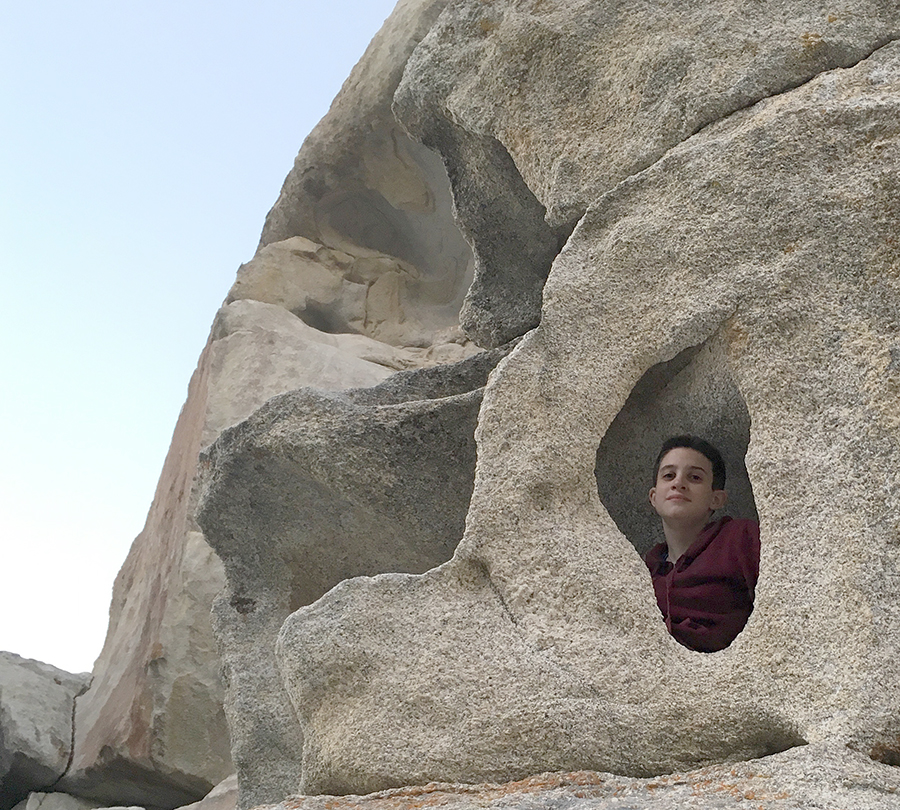Geology
The City of Rocks National Reserve and Castle Rocks State Park comprise a geologic wonderland that showcases an amazing landscape of spires created from erosion of two bodies of granite, one 26 million years old and the other 2.5 billion years old. Millions of years of uplift and erosion has created a “city” of granite spires of many shapes and sizes. The spires have been sculpted by weathering and erosion, producing interesting features such as windows and arches as well as the knobs and plates that provide hand holds for over a thousand established rock climbs.
For more information please refer to our Geology References page.
Granite Types
The spires of City of Rocks and Castle Rocks are composed of two different types of granitic rock that were formed at vastly different times. Most of the spires are made of granite and granodiorite of the Almo pluton (1), which consists of tiny crystals of generally equal size of feldspar, quartz, and mica. The Almo pluton was a large body of magma that cooled and crystallized while it was still 10-15 km below the surface around 30 million years ago. The other granite belongs to suite of rocks called the Green Creek Complex (2), which cooled and crystallized 2500 million years ago. The granite of the Green Creek Complex can be distinguished from the Almo pluton granite by its large rectangular feldspar crystals. Most of the outcrops on the ridge that separates the City of Rocks from Castle Rocks are composed of Green Creek Complex granite.


Grus
The basic raw material for the soils at City of Rocks and Castle Rocks is a coarse sand called grus, which is composed of fragments of crystals of feldspar, quartz, and mica derived from the weathering of the granite bedrock. Chemical reactions facilitated by rain water and the mechanical action of freeze-thaw cycles combine to break the granite apart along the boundaries of its constituent crystals.
Pickelhaube
Many spires in City of Rocks and Castle Rocks are capped by small rock spikes. These features have been named “pickelhaube” (pickle-haw-ba) for their resemblance to spiked German military helmets. They represent the last remnant of a crust on the surface of the rock that has largely decomposed. It may be that they resist weathering due to a coating of droppings from the birds that utilize them for perches.


Dikes
This photo of the “Roadmap wall” in City of Rocks shows light-colored dikes of Almo pluton granite intruding darker colored granite of the Green Creek Complex. The dikes were created when pressure from the main body of the Almo pluton magma produced cracks in the overlying Green Creek Complex granite. Almo pluton granitic magma then squirted into the cracks and crystallized, forming the dikes.
Exfoliation
These outcrops of Almo pluton granite are cut by closely-spaced parallel cracks called exfoliation joints. The cracks form in response to the release of pressure on the rocks as overlying rock is removed by weathering and erosion.


Flares
These spires in City of Rocks have smooth overhanging concave flanks, known as flared slopes. These features develop below the ground surface as the flanks of the spire are chemically attacked by the water in saturated soils. The weathered area is then exposed as the surrounding soils are eroded away. Flared slopes are thus an indication of an area where the ground surface is being subjected to erosion (degredation).
Joints
The prominent vertical cracks in granite of the Almo pluton at the Breadloaves formation at City of Rocks are known as joints. Joints can form in response to tensional stresses imposed by contraction of the cooling granitic magma or by tectonic forces experienced by the granite after it cooled and crystallized.


Pegmatite
In places, the granite outcrops of City of Rocks and Castle Rocks contain areas of rock where the crystals of quartz, felspar, and mica minerals that compose the rock are exceptionally large, with diameters exceeding 2 inches. These coarse-grained zones within the granite are known as pegmatites, and they represent silica and water-rich parts of the magma that were the last to crystallize.
Cavernous Weathering
The granite outcrops of City of Rocks and Castle Rocks feature hollows, windows, and arches created by a process called cavernous weathering, which is facilitated by microscopic wind-borne particles of salt. The salt particles crystallize between the grains of the granite, causing them crumble.

































